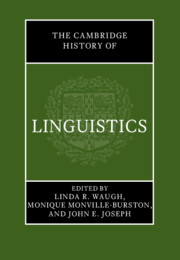Book contents
- The Cambridge History of Linguistics
- The Cambridge History of Linguistics
- Copyright page
- Dedication
- Contents
- Figures
- Tables
- Contributors
- Preface
- Acknowledgments
- Abbreviations, Acronyms, Special Symbols, and Other Conventions
- Introduction
- Part I Ancient, Classical, and Medieval Periods
- Part II Renaissance to Late Nineteenth Century
- Part III Late Nineteenth-through Twentieth-Century Linguistics
- Part IIIA Late Nineteenth Century through the 1950s: Synchrony, Autonomy, and Structuralism
- Part IIIB 1960–2000: Formalism, Cognitivism, Language Use and Function, Interdisciplinarity
- 17 Chomsky and the Turn to Syntax, Including Alternative Approaches to Syntax
- 18 Functionalist Dimensions of Grammatical and Discourse Analysis
- 19 Semantics and Pragmatics
- 20 Language and Philosophy, from Frege to the Present
- 21 Lexicology and Lexicography
- 22 Generative Phonology: its Origins, its Principles, and its Successors
- 23 Phonetics and Experimental Phonology, c. 1950–2000
- 24 Historical and Universal-Typological Linguistics
- 25 Language and Society
- 26 Language and Anthropology
- 27 Language and Psychology, 1950–Present: A Brief Overview
- 28 Semiotics
- 29 Applied Linguistics
- References
- Index
29 - Applied Linguistics
from Part IIIB - 1960–2000: Formalism, Cognitivism, Language Use and Function, Interdisciplinarity
Published online by Cambridge University Press: 20 July 2023
- The Cambridge History of Linguistics
- The Cambridge History of Linguistics
- Copyright page
- Dedication
- Contents
- Figures
- Tables
- Contributors
- Preface
- Acknowledgments
- Abbreviations, Acronyms, Special Symbols, and Other Conventions
- Introduction
- Part I Ancient, Classical, and Medieval Periods
- Part II Renaissance to Late Nineteenth Century
- Part III Late Nineteenth-through Twentieth-Century Linguistics
- Part IIIA Late Nineteenth Century through the 1950s: Synchrony, Autonomy, and Structuralism
- Part IIIB 1960–2000: Formalism, Cognitivism, Language Use and Function, Interdisciplinarity
- 17 Chomsky and the Turn to Syntax, Including Alternative Approaches to Syntax
- 18 Functionalist Dimensions of Grammatical and Discourse Analysis
- 19 Semantics and Pragmatics
- 20 Language and Philosophy, from Frege to the Present
- 21 Lexicology and Lexicography
- 22 Generative Phonology: its Origins, its Principles, and its Successors
- 23 Phonetics and Experimental Phonology, c. 1950–2000
- 24 Historical and Universal-Typological Linguistics
- 25 Language and Society
- 26 Language and Anthropology
- 27 Language and Psychology, 1950–Present: A Brief Overview
- 28 Semiotics
- 29 Applied Linguistics
- References
- Index
Summary
Three definitions are given of the (debated) nature of ‘Applied Linguistics’ (AL):
(1) foreign language (L2) teaching/learning;
(2) use of linguistic knowledge to solve problems where language is a central issue;
(3) anything related to language except theoretical linguistics.
Rejecting (3), the authors develop specific aspects of definitions (1) and (2).
Definition (1):
- Relation between language theory and AL: main approaches to L2 teaching (e.g., Reform Movement, structuralist and behaviorist trends, contrastive analysis, audiolingual methods, L2 development (error analysis and interlanguage — supported by generative theory);
- Interdisciplinarity: research in L2 (cognitive) psycholinguistics: experimental investigations on language processing, e.g., language activation by bilinguals;
- Interdisciplinarity: growing interest in the social contexts of L2 acquisition: development of ‘communicative language teaching,’ of usage-based teaching (with corpora), attention paid to learners’ age/gender/social class and the sociocultural context of development.
Definition (2):
- Focus on multilingualism: cognitive advantage/disadvantage of bi/multilingualism;
- Language policy and planning in AL;
- International, national, local policies (CEFR, ACTFL);
- The spread of English, local standards of English;
- Bilingual education (immersion, CLIL).
- Language testing: psychometric-structuralist, integrative-sociolinguistic approaches, moral/ethical dilemmas in testing;
- Neurolinguistic issues related to bilingual aphasia (e.g., affected areas of the brain and location of language in the brain; use of modern tools (ERP, fMRI) for research).
Keywords
- Type
- Chapter
- Information
- The Cambridge History of Linguistics , pp. 885 - 910Publisher: Cambridge University PressPrint publication year: 2023

